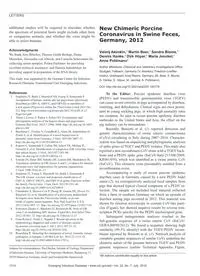
2016 New Chimeric Porcine Coronavirus in Swine Feces, Germany, 2012 PDF
Preview 2016 New Chimeric Porcine Coronavirus in Swine Feces, Germany, 2012
additional studies will be required to elucidate whether the spectrum of potential hosts might include other farm or companion animals, and whether the virus might be able to infect humans. Acknowledgments We thank Jens Böttcher, Thomas Große Beilage, Diana Meemken, Alexandra von Altrock, and Cornelia Schwennen for collecting serum samples; Polina Parfentev for providing excellent technical assistance; and Daniela Indenbirken for providing support in preparation of the RNA library. This study was supported by the German Center for Infection Research/Thematic Translational Unit Emerging Infections. References 1. Stapleton JT, Bukh J, Muerhoff AS, Foung S, Simmonds P. Assignment of human, simian and bat pegiviruses (previously described as GBV-A, GBV-C, and GBV-D) as members of a new genus (Pegivirus) within the Flaviviridae [cited 2015 Oct 21]. http://www.ictvonline.org/proposals/2012.011a-dV.A.v2. Pegivirus.pdf 2. Thézé J, Lowes S, Parker J, Pybus OG. Evolutionary and phylogenetic analysis of the hepaciviruses and pegiviruses. Genome Biol Evol. 2015;7:2996–3008. http://dx.doi.org/10.1093/ gbe/evv202 3. Baechlein C, Fischer N, Grundhoff A, Alawi M, Indenbirken D, Postel A, et al. Identification of a novel hepacivirus in domestic cattle from Germany. J Virol. 2015;89:7007–15. http://dx.doi.org/10.1128/JVI.00534-15 4. Kapoor A, Simmonds P, Cullen JM, Scheel TK, Medina JL, Giannitti F, et al. Identification of a pegivirus (GB virus-like virus) that infects horses. J Virol. 2013;87:7185–90. http://dx.doi.org/10.1128/JVI.00324-13 5. Simons JN, Desai SM, Schultz DE, Lemon SM, Mushahwar IK. Translation initiation in GB viruses A and C: evidence for internal ribosome entry and implications for genome organization. J Virol. 1996;70:6126–35. 6. Stapleton JT, Foung S, Muerhoff AS, Bukh J, Simmonds P. The GB viruses: a review and proposed classification of GBV-A, GBV-C (HGV), and GBV-D in genus Pegivirus within the family Flaviviridae. J Gen Virol. 2011;92:233–46. http://dx.doi.org/10.1099/vir.0.027490-0 7. Chandriani S, Skewes-Cox P, Zhong W, Ganem DE, Divers TJ, Blaricum AJ, et al. Identification of a previously undescribed divergent virus from the Flaviviridae family in an out- break of equine serum hepatitis. Proc Natl Acad Sci U S A. 2013;110:E1407–15. http://dx.doi.org/10.1073/pnas.1219217110 8. Schwarze-Zander C, Blackard JT, Rockstroh JK. Role of GB virus C in modulating HIV disease. Expert Rev Anti Infect Ther. 2012;10:563–72. http://dx.doi.org/10.1586/eri.12.37 9. Grau-Roma L, Fraile L, Segalés J. Recent advances in the epidemiology, diagnosis and control of diseases caused by porcine circovirus type 2. Vet J. 2011;187:23–32. http://dx.doi.org/10.1016/j.tvjl.2010.01.018 10. Rosenberg R. Detecting the emergence of novel, zoonotic viruses pathogenic to humans. Cell Mol Life Sci. 2015;72:1115–25. http://dx.doi.org/10.1007/s00018-014-1785-y Address for correspondence: Paul Becher, Institute of Virology, Department of Infectious Diseases, University of Veterinary Medicine, Buenteweg 17, 30559 Hannover, Germany; email:
